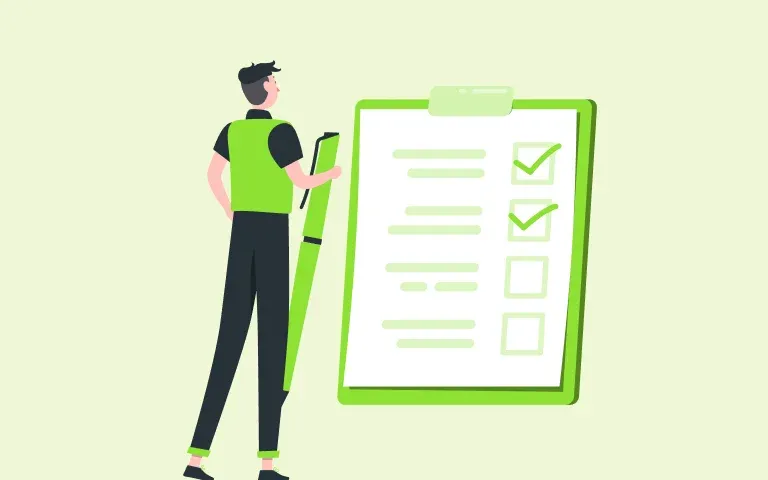The Ultimate Guide to Writing an Effective Informative Essay Outline
Learn the important steps to create an informative essay outline. Write an informative essay outline with clarity.

Are you struggling to organize your thoughts for an informative essay?
You're not alone! Many students find it challenging to create a clear and effective outline. But don't worry – we've got you covered. In this ultimate guide, we'll walk you through the process of crafting a perfect outline for your informative essay.
Writing an essay can often feel overwhelming, especially when you have a lot of information to convey. An outline acts like a roadmap, helping you arrange your thoughts logically and ensuring that you cover all the necessary points. It not only makes the writing process easier but also helps you stay focused and organized.
In this guide, we'll break down the components of an informative essay outline step-by-step. You'll learn how to create a strong introduction that grabs your reader's attention, develop well-structured body paragraphs that present your information clearly, and write a conclusion that leaves a lasting impression. We'll also share tips and tricks to make your outline more effective and help you avoid common pitfalls.
By the end of this post, you'll have all the tools you need to structure your essay in a way that makes writing it a breeze. Whether you're a seasoned writer looking to refine your skills or a beginner unsure where to start, this guide will provide you with the guidance you need to succeed.
Let's dive in and turn that blank page into a well-organized roadmap to a successful essay!
What Is an Informative Essay?

An informative essay is a type of writing that explains a specific topic or subject. Its main goal is to provide information clearly, concisely, and in an organized way. The purpose is to help the reader understand the topic better.
Unlike persuasive or argumentative essays, which aim to convince the reader of a particular viewpoint, informative essays are written to present facts. They should be unbiased, objective, and free from personal opinions.
When writing an informative essay, it's important to choose a topic that interests your audience and is relevant to them. You should also conduct thorough research using reliable sources like academic journals, books, and reputable websites. Additionally, use clear language, proper grammar, and a formal tone.
An informative essay usually follows a basic structure: an introduction, body paragraphs, and a conclusion. The introduction provides background information and a clear thesis statement. The body paragraphs present key points with supporting evidence. The conclusion summarizes the information presented.
How to Create a High Quality Informative Essay Outline

Making an outline for an informative essay is an important step in the writing process. An outline gives your essay a clear structure, helping you organize your thoughts and ideas before you start writing. A good outline ensures that your essay is clear, concise, and well-organized.
Here’s a simple way to structure your informative essay outline:
I. Introduction
The introduction sets the stage for your essay. It provides background information on the topic and introduces the thesis statement, which is the main idea of your essay. The introduction should also grab the reader's attention and encourage them to keep reading.
A. Hook: The hook is the opening sentence or two of your essay. It should be interesting and relevant to the topic.
B. Background Information: This gives context to the topic and helps the reader understand its importance.
C. Thesis Statement: The thesis statement clearly states the main idea of your essay. It should be specific and concise.
II. Body Paragraphs
The body paragraphs contain the detailed information about your topic. Each paragraph should focus on a specific aspect of the topic and be organized logically.
A. Topic Sentence: This is the first sentence of each body paragraph. It states the main point of the paragraph.
B. Supporting Details: These are the facts, examples, and evidence that support the topic sentence.
C. Transitions: Transitions help connect the paragraphs and make the essay flow smoothly.
III. Conclusion
The conclusion wraps up your essay. It summarizes the informative essay structures main points and restates the thesis statement in a new way. The conclusion should leave a lasting impression on the reader.
A. Restate Thesis Statement: Rephrase your thesis statement to remind the reader of the main idea.
B. Summarize Main Points: Briefly summarize the key points discussed in the essay.
C. Final Thoughts: End with a strong closing statement that leaves a lasting impression.
By following this outline example, you can create an informative writing essay that is clear, concise, and well-structured. This essay writing outline strategy helps you cover all the important points and ensures your essay flows logically from start to finish.
8 Steps to Writing an Informative Essay Format

Although all essays follow a similar structure, each type has its unique features and details. Knowing these differences is essential for creating a well-organized informative research paper outline. An effective outline helps you arrange your thoughts and ideas, ensuring you include all the necessary information.
Here’s a simple guide to help you write a well-organized informative essay:
1. Choose a Topic
Start by picking a topic that you find interesting and that will also engage your audience. When you choose a topic you care about, writing the essay becomes more enjoyable. Additionally, make sure the topic is relevant to your audience so they will find it interesting too. It’s important to pick a topic that has plenty of information available.
This will make your research paper easier and ensure you have enough material to support your essay. If you choose a topic that is too narrow, you might struggle to find enough sources. If it’s too broad, you might feel overwhelmed with too much information. Aim for a balanced topic that is both interesting and manageable.
2. Do Your Research
Once you have chosen your topic, it's time to gather information. Start by looking for reliable sources such as books, academic journals, and reputable websites. These sources are trustworthy and provide accurate information that will help strengthen your essay.
As you read through your sources, take notes on the important points and details. Write down key facts, statistics, and examples that relate to your topic. This will help you remember the information and make it easier to organize later.
Be sure to keep track of where you found your information. This will be useful when you need to cite your sources in your essay. Organizing your notes by main points or subtopics can help you stay organized and ensure you cover all the necessary information in your essay.
3. Create an Outline
Before you start writing your essay, it's helpful to organize your thoughts by creating an outline. An outline acts like a roadmap, guiding you through the writing process and ensuring you don't forget any important points.
Start by dividing your outline into three main sections: the introduction, the body paragraphs, and the conclusion.
Introduction: This section will introduce your topic to the reader. It should include a hook to grab their attention, some background information to set the context, and a thesis statement that clearly states the main idea of your essay.
Body Paragraphs: These are the main sections of your essay where you will present your information. Each body paragraph should focus on a specific point or aspect of your topic. Begin each paragraph with a topic sentence that states the main idea of the paragraph, followed by supporting details such as facts, examples, and evidence. Be sure to use transitions to help your paragraphs flow smoothly from one to the next.
Conclusion: In this final section, you will summarize the main points of your essay and restate your thesis in a new way. The conclusion should also leave the reader with a final thought or impression.
4. Write the Introduction
The introduction is the first part of your essay, and it’s important to make a strong start. Begin with a hook—this is a sentence or two that grabs your reader’s attention and makes them want to read more. The hook can be an interesting fact, a question, a quote, or a brief anecdote related to your topic.
After the hook, provide some background information about your topic. This helps set the context for your reader and gives them a better understanding of what you will be discussing. Background information should include any key terms or concepts that are necessary to understand your essay.
Finally, end your introduction with your thesis statement. The thesis statement is a clear, concise sentence that states the main idea or purpose of your essay. It tells the reader exactly what to expect from the rest of the essay.
For example:
- Hook: "Did you know that nearly 70% of all jobs require some form of technical skills?"
- Background Information: "As technology continues to evolve, the demand for tech-savvy employees is higher than ever. From basic computer literacy to advanced programming, technical skills are essential in today’s job market."
- Thesis Statement: "This essay will explore the most in-demand technical skills for 2024 and provide tips on how to acquire them."
By following this structure, your introduction will effectively set the stage for your essay, engaging your reader and clearly outlining what they will learn.
5. Develop Body Paragraphs
The body paragraphs are the main part of your essay where you present your information in detail. Each paragraph should focus on a specific aspect of your topic. Here's how to develop your body paragraphs:
Start with a Topic Sentence: Each paragraph should begin with a topic sentence. This sentence introduces the main idea of the paragraph and tells the reader what to expect. It should be clear and directly related to your thesis statement.
Add Supporting Details: After the topic sentence, include supporting details to explain and back up the main idea. These details can be facts, statistics, examples, quotes, or any other relevant information. Make sure each piece of evidence directly supports the topic sentence.
Use Transitions: Transitions are words or phrases that help connect your paragraphs and make your essay flow smoothly. They guide the reader from one idea to the next. Examples of transitions include words like "furthermore," "in addition," "however," and "on the other hand." Use transitions at the beginning of new paragraphs or within paragraphs to link related ideas.
6. Write the Conclusion
The conclusion is the final part of your essay, and it’s your last chance to leave a strong impression on your reader. Here’s how to write a clear and effective conclusion:
Summarize the Main Points: Begin by briefly summarizing the main points you made in your essay. This helps to remind the reader of what you discussed and reinforces your key ideas. Don’t introduce any new information here—just focus on the main points you’ve already covered.
Restate Your Thesis: Next, restate your thesis statement, but do it in a new way. This means you should rewrite it so it doesn’t sound exactly like it did in your introduction. The goal is to remind the reader of the central idea of your essay and show how the points you made support it.
End with a Final Thought: Conclude your essay with a final thought that leaves a lasting impression on the reader. This could be a call to action, a thought-provoking question, a quote, or a prediction about the future. The aim is to end on a strong note that makes your reader think about your topic even after they’ve finished reading.
7. Edit and Revise
After you finish writing your essay, it's important to review it carefully to make sure it’s the best it can be. Here’s how to edit and revise your work:
Look for Mistakes: Read through your essay and check for any grammar, punctuation, and spelling errors. Fix any mistakes you find. This will make your essay look more professional and easier to read.
Improve Clarity: Make sure your essay is clear and easy to understand. Look for any sentences or paragraphs that are confusing or unclear and rewrite them to make them more straightforward. Your goal is to make sure your ideas are presented clearly.
Check the Flow: Ensure that your essay flows smoothly from one idea to the next. Each paragraph should connect logically to the next one. If something seems out of place or choppy, use transitions to help connect your ideas better.
Read Aloud: Reading your essay out loud can help you catch mistakes or awkward phrasing that you might miss when reading silently. It also helps you hear how your essay sounds and whether it flows well.
Get Feedback: If possible, ask a friend, family member, or teacher to read your essay and give you feedback. They might notice mistakes you missed or suggest ways to improve your writing.
Take Your Time: Don’t rush the editing process. Take your time to review your essay carefully and make any necessary changes. It’s okay to go through multiple drafts to get it right.
8. Proofread
The final step in writing your essay is to proofread it carefully. This is your last chance to catch any remaining errors and make sure your essay is as perfect as possible. Here’s how to do it:
Read Through One Last Time: Go through your entire essay from start to finish. Look for any mistakes you might have missed earlier, such as typos, spelling errors, or grammar issues. Pay close attention to every word and sentence.
Check for Consistency: Make sure that your essay is consistent in terms of style and tone. Check that your formatting is uniform throughout the document, such as font size, headings, and spacing.
Focus on Punctuation: Punctuation errors can easily slip through, so be sure to check for correct use of commas, periods, quotation marks, and other punctuation marks.
Ask for Help: Sometimes, a fresh pair of eyes can spot mistakes that you might overlook. Ask a friend or family member to read your essay and give you feedback. They might notice things you didn’t see.
Read Aloud: Reading your essay out loud can help you catch awkward phrasing or sentences that don’t sound quite right. It also helps you hear the flow of your essay and make sure it sounds smooth and coherent.
Take Breaks: If you have time, take breaks between your proofreading sessions. Looking at your essay with fresh eyes after a break can help you catch more errors.
In-Depth Examination of Each Subsection in an Essay Outline Format

Outlines for informative papers typically consist of the same five or six parts as those for other kinds of essays. This type of writing task usually requires a specific structure. Begin with a one-paragraph opening, then move on to the body—which should be at least three paragraphs long—and end with a closing. This will likely appear recognizable to you.
Let's take a closer look at each part of the research report. Ensure that you have a clear picture of what each paragraph will address.
In the introduction of your informative essay, you should define your subject in simple terms. Instead of relying on your own assumptions, make sure you use actual definitions from reputable sources. You can also include some background information or "prehistory" of the subject, which might contain interesting facts that aren't commonly known.
In the body of your essay, you will support the thesis statement you made in the introduction. It's a good idea to dedicate each paragraph to a single main idea, so the number of body paragraphs will depend on how many points you want to make. Each body paragraph should focus on one main idea or argument. Begin with a topic sentence that states the idea clearly. Provide evidence, examples, and explanations to support each idea. Include information from reliable sources to back up your points.
Sometimes, you might need to address opposing viewpoints or counterarguments. Make sure you've done your research and have all the necessary information to present a well-reasoned response. Understand that there can be different perspectives on the topic, so gather evidence carefully and present your opponent's arguments fairly. Each point you make should be supported by evidence. Mention the names of scientists, scholars, or experts who provided the information. This helps paint a clear and vivid picture of the topic.
Many students mistakenly believe that the conclusion should simply repeat the thesis statement. Instead, the conclusion should summarize the main points of your essay and highlight the most important findings. Rephrase your thesis statement in a new way to remind the reader of your main idea. Briefly go over the key points discussed in the body of your essay. Explain how the reader can benefit from understanding the study findings. Point out the significance of the information and its potential impact.
3 Informative Essay Examples

Example 1: The Benefits of Regular Exercise
a. Introduction
Regular exercise is essential for maintaining good health. In this essay, we'll explore how exercise helps improve physical fitness, boost mental well-being, and prevent chronic diseases. Understanding these benefits will motivate you to incorporate more physical activity into your daily routine, improving your overall quality of life.
b. Improving Physical Fitness
Engaging in activities like running, swimming, or lifting weights strengthens muscles and increases endurance. These exercises enhance cardiovascular health, flexibility, and overall physical performance, contributing to a healthier body.
c. Boosting Mental Well-being
Exercise releases endorphins, chemicals in the brain that act as natural mood lifters. Regular physical activity can reduce stress, anxiety, and depression, promoting a more positive outlook on life and better mental health.
d. Preventing Chronic Diseases
Regular exercise helps manage weight and improve cardiovascular health, which is crucial for preventing chronic diseases such as heart disease, diabetes, and obesity. By staying active, you can significantly reduce your risk of developing these conditions.
Conclusion
Incorporating regular exercise into your daily routine offers numerous benefits, including improved physical fitness, enhanced mental well-being, and prevention of chronic diseases. By understanding and embracing these advantages, you can lead a healthier and more fulfilling life.

Example 2: The Basics of Recycling
a. Introduction
Recycling plays a crucial role in protecting our environment. This essay will explain what recycling is, how it works, and why it's important. By understanding the basics of recycling, you'll be encouraged to make more eco-friendly choices in your daily life.
b. What is Recycling?
Recycling involves converting waste materials into new products, reducing the need for raw materials and decreasing environmental impact. Common materials that can be recycled include paper, plastic, glass, and metal.
c. How Does Recycling Work?
The recycling process includes collecting and sorting recyclable materials, processing them into raw materials, and manufacturing new products. This process helps conserve natural resources, save energy, and reduce pollution.
d. Why is Recycling Important?
Recycling reduces landfill waste, saves energy, and conserves natural resources. It also helps protect the environment by reducing the need for new raw materials and decreasing greenhouse gas emissions.
e. Easy Ways to Start Recycling at Home
Setting up separate bins for different materials and educating yourself on what can and cannot be recycled are simple steps to start recycling at home. Making recycling a part of your daily routine can have a significant positive impact on the environment.
Conclusion
Understanding the basics of recycling and its importance encourages more eco-friendly choices. By incorporating simple recycling practices into your daily life, you can help protect the environment and promote a sustainable future.

Example 3: The History of the Internet
Introduction
The internet has transformed the way we live and communicate. In this essay, we'll take a look at the origins of the internet, how it has evolved over the years, and its impact on society today. By learning about the history of the internet, you can better appreciate its role in our modern world.
a. The Origins of the Internet
The internet began as a military project in the 1960s, known as ARPANET, designed to allow communication between computers over long distances. Key technologies like TCP/IP protocols laid the foundation for the internet we use today.
b. Evolution of the Internet
The development of the World Wide Web and browsers in the 1990s made the internet accessible to the public. This evolution revolutionized communication, information access, and entertainment, changing the way we interact with technology.
c. Impact on Society
The internet's impact on society includes revolutionizing communication through email and social media, changing the way we access information, and influencing business through e-commerce. It has become an integral part of our daily lives.
Conclusion
The history of the internet highlights its profound impact on modern society. By understanding its origins and evolution, we can better appreciate the technological advancements that have shaped our world and continue to influence our lives.
Conclusion
Creating an effective outline is an important step in writing a clear and well-organized informative essay. By following the steps outlined in this guide, you can ensure that your essay is structured logically and covers all the necessary points.
An outline helps you organize your thoughts, stay on track, and make the writing process much smoother. Remember, a well-planned outline leads to a well-written essay, making it easier for your readers to understand and engage with your topic.
Ready to create an effective informative essay outline?
Let v0 Report help you! Our powerful tool assists you in organizing your thoughts and structuring your essay for maximum impact.
Visit v0 Report today and experience how our informative essay outline tool can make your writing process easier and more efficient.
Start outlining your informative essay outline now!
Frequently Asked Questions
1. What are 5 examples of informative writing?
Five examples of informative writing include:
News Articles: These provide factual information about current events and topics of public interest.
Instruction Manuals: These offer step-by-step instructions on how to use a product or perform a task.
Textbooks: These educational books provide detailed information on specific subjects to help students learn.
Research Papers: These academic papers present original research and findings on a particular topic.
Encyclopedia Entries: These provide concise and factual information on a wide range of topics for general knowledge.
2. What are 3 parts of an informative essay?
The three parts of an informative essay are:
Introduction: This section introduces the topic, provides background information, and presents the thesis statement.
Body Paragraphs: These paragraphs each focus on a specific aspect of the topic, providing detailed information, evidence, and examples.
Conclusion: This part summarizes the main points of the essay and restates the thesis in a new way, leaving a lasting impression on the reader.
3. What is informative writing in essay?
Informative writing in an essay involves presenting factual information about a specific topic in a clear, concise, and organized manner. The purpose is to educate the reader on the subject without including personal opinions or persuasive elements. The essay should be well-researched and provide a comprehensive understanding of the topic.
4. What are informative essay topics?
Informative essay topics are subjects that provide factual information and educate the reader. Examples include: the benefits of renewable energy, the history of the internet, how vaccines work, the impact of climate change on the environment, and the process of photosynthesis in plants.
5. What is the purpose of an informative essay topic?
The purpose of an informative essay topic is to educate and inform the reader about a specific subject. The goal is to present facts, data, and explanations in a clear and organized way, helping the reader gain a deeper understanding of the topic without the influence of personal opinions or biases.



